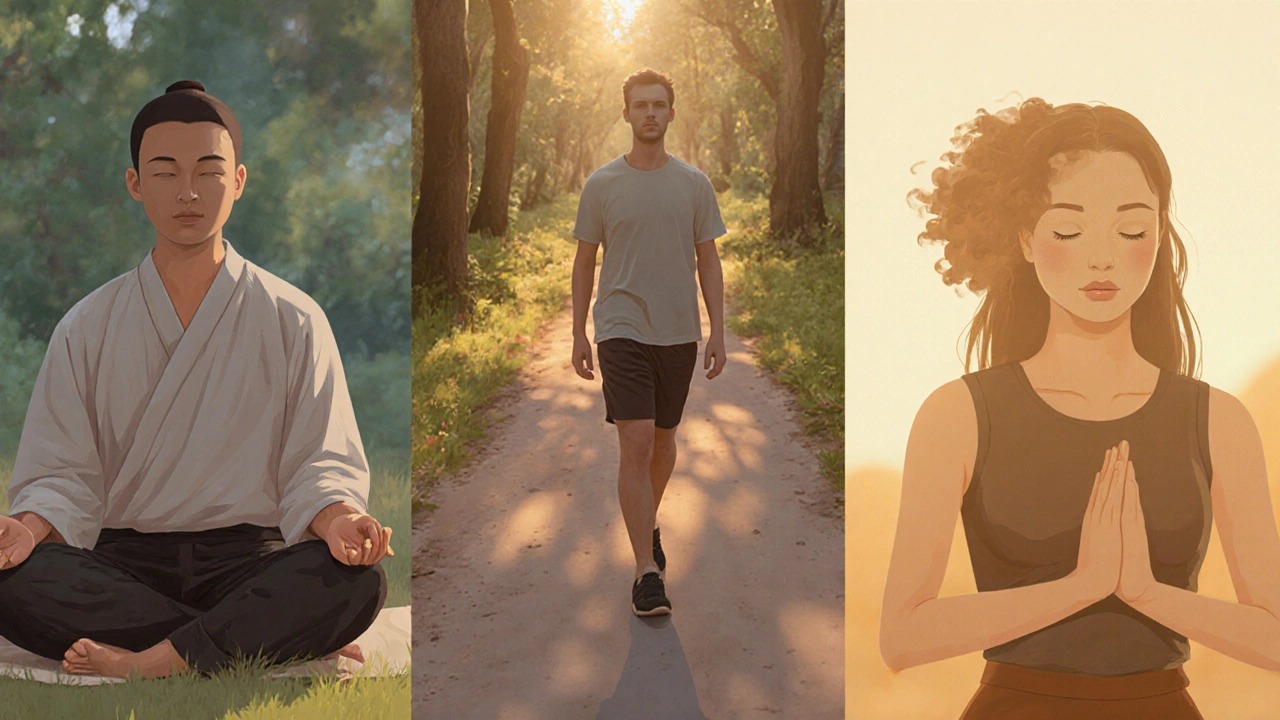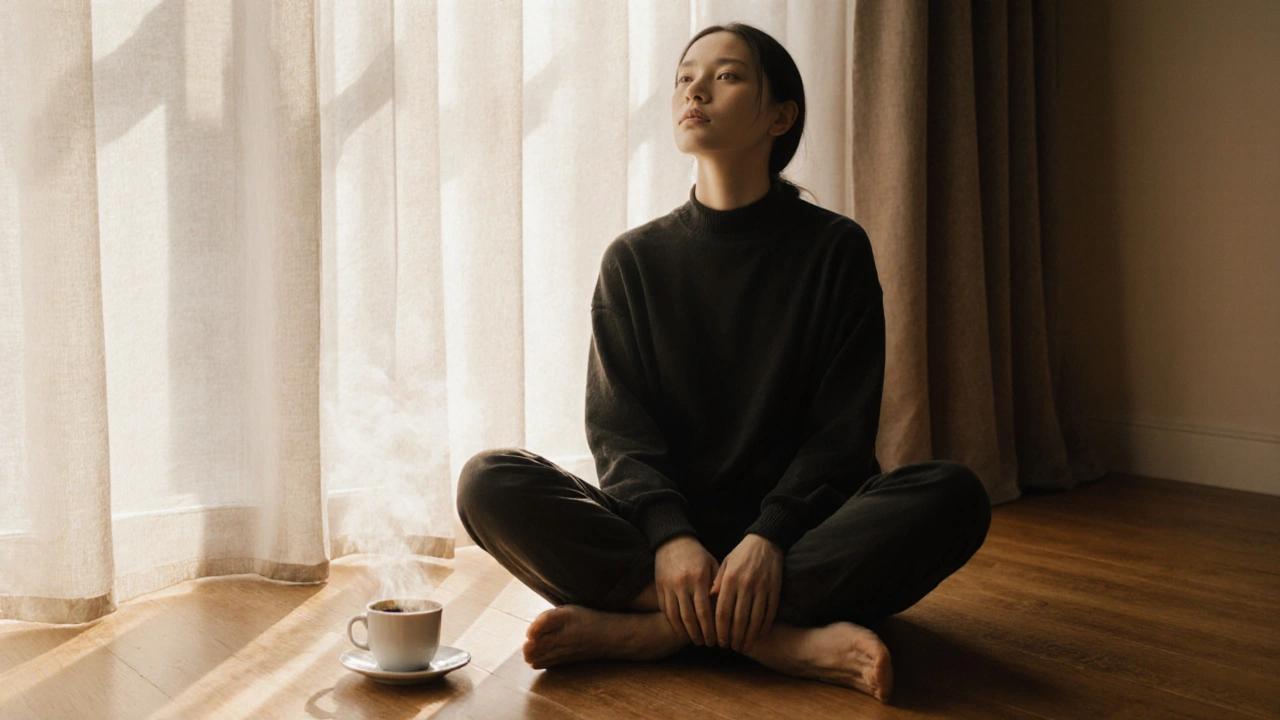Meditation Type Selector
Find Your Perfect Meditation Practice
Discover which meditation type matches your current needs and lifestyle. Take this 2-minute quiz to get personalized recommendations.
Not all meditation is the same. If you’ve ever sat down to meditate and felt like you were doing it wrong, you’re not alone. The problem isn’t you-it’s that most people think meditation means sitting cross-legged and clearing your mind. But that’s just one tiny piece of a much bigger puzzle. There are dozens of meditation practices, each with its own rhythm, focus, and purpose. Some calm your nervous system. Others help you reconnect with emotions you’ve buried. A few even train your brain to notice thoughts without getting tangled in them. The right type of meditation isn’t about what looks peaceful on Instagram-it’s about what actually works for your life right now.
Mindfulness Meditation
Mindfulness meditation is the most studied and widely taught form today. It’s not about stopping thoughts. It’s about noticing them-without judgment. You sit quietly, focus on your breath, and when your mind wanders (and it will), you gently bring it back. That’s it. No fancy chants. No special posture. Just awareness.
This practice isn’t new. It comes from ancient Buddhist traditions, but modern science has caught up. A 2023 study from Harvard Medical School found that just eight weeks of daily mindfulness meditation reduced activity in the amygdala-the brain’s fear center-by 18%. People reported feeling less reactive to stress, even during busy workdays or family conflicts.
If you’re overwhelmed, anxious, or stuck in a loop of overthinking, mindfulness gives you a reset button. You don’t need to meditate for an hour. Five minutes while waiting for your coffee to brew counts. Apps like Insight Timer or Healthy Minds Program offer free guided sessions that walk you through it step by step.
Transcendental Meditation (TM)
Transcendental Meditation is different. It doesn’t ask you to focus on your breath or observe thoughts. Instead, you silently repeat a personalized mantra-a sound without meaning-while sitting comfortably with your eyes closed. The goal isn’t to control your mind, but to let it settle naturally into deeper states of rest.
TM was popularized in the 1960s by Maharishi Mahesh Yogi and gained fame when The Beatles studied with him. Today, it’s backed by over 400 peer-reviewed studies. One 2021 meta-analysis in the Journal of Clinical Psychology showed TM reduced symptoms of PTSD in veterans more effectively than cognitive behavioral therapy in some cases.
Here’s the catch: TM is taught through certified instructors, and training costs several hundred dollars. That’s because the mantra is chosen based on your age, background, and other personal factors. It’s not something you pick from a YouTube video. If you’re curious, try a free introductory session first. Many centers offer them.
Loving-Kindness Meditation (Metta)
What if meditation could help you feel less angry at your boss-or even your ex? Loving-kindness meditation, or Metta, is designed for exactly that. It starts with sending goodwill to yourself: “May I be safe. May I be happy. May I be healthy.” Then you slowly extend those wishes to others: a friend, a neutral person, someone you struggle with, and finally, all living beings.
This isn’t fluffy spirituality. Brain scans show that regular Metta practice increases activity in the prefrontal cortex-the area tied to empathy and emotional regulation. A 2022 study from the University of Wisconsin found that participants who practiced Metta for six weeks showed higher levels of oxytocin, the bonding hormone, and reported feeling more connected to others.
If you’ve ever felt isolated, bitter, or emotionally numb, this one can shift something deep inside. It doesn’t require silence. You can do it while walking, commuting, or even washing dishes. Just repeat the phrases softly in your head. Start small. One person at a time.

Body Scan Meditation
When stress hits, your body tenses up-shoulders, jaw, belly, toes. But most of us don’t notice until we’re in pain. Body scan meditation reconnects you with those signals. You lie down or sit comfortably and slowly bring your attention from your toes up to your head, noticing sensations without trying to change them.
This is the cornerstone of Mindfulness-Based Stress Reduction (MBSR), the program developed by Jon Kabat-Zinn at the University of Massachusetts Medical School. It’s used in hospitals for chronic pain, cancer recovery, and insomnia. A 2020 clinical trial found that patients with fibromyalgia who did daily body scans for eight weeks reported a 30% drop in pain intensity.
It’s not about relaxation. It’s about awareness. You might feel tingling, warmth, pressure, or nothing at all. All of it’s okay. The point is to stop ignoring your body. If you’re someone who lives in your head, this practice brings you back into your skin.
Zen Meditation (Zazen)
Zen meditation, or Zazen, is the heart of Japanese Zen Buddhism. It’s simple on the surface: sit upright, hands resting in your lap, eyes half-open, focused on your breath. But beneath that simplicity is a radical discipline. You don’t chase thoughts. You don’t push them away. You let them pass like clouds.
Zen doesn’t promise calm. It promises clarity. In traditional practice, you sit for 20-40 minutes at a time, often twice a day. Beginners are encouraged to start with 10 minutes. The posture matters-spine straight, chin slightly tucked, shoulders relaxed. It’s not about comfort. It’s about presence.
Studies show Zazen increases gray matter in areas linked to attention and self-control. A 2019 MRI study from Stanford found long-term Zen practitioners had thicker cortical regions than non-meditators, even when matched for age and lifestyle. If you’re drawn to structure, ritual, or quiet intensity, Zen might be your match.

Guided Meditation and Movement-Based Practices
Not everyone sits still. That’s where guided meditations and movement-based practices come in. Guided meditations use a voice to lead you through imagery-walking through a forest, floating on water, or standing on a mountaintop. These are great for beginners who find silence intimidating.
Movement-based types include yoga, tai chi, and qigong. These aren’t workouts. They’re meditations in motion. Your attention stays on the flow of breath and the feel of each movement. A 2024 review in Frontiers in Neurology showed that tai chi improved balance and reduced anxiety in older adults better than traditional aerobic exercise.
If you hate sitting still, don’t force it. Try walking meditation. Walk slowly. Feel each foot touching the ground. Notice the air on your skin. Count your steps. That’s meditation too.
How to Choose the Right One for You
There’s no universal best. The right type of meditation depends on what you need right now.
- Need to quiet racing thoughts? Try mindfulness or body scan.
- Feel emotionally distant or resentful? Try loving-kindness.
- Prefer structure and silence? Try Zen.
- Want deep rest without effort? Try Transcendental Meditation.
- Can’t sit still? Try guided or movement-based practices.
Give each one a fair shot. Try one for at least seven days. Don’t judge it after one session. Meditation is like learning to ride a bike. You don’t get it on the first try. But after a week, something shifts.
Keep a simple journal: How did you feel before? After? Did your mind settle? Did your body relax? Did you feel more patient? That’s your signal.
Common Mistakes to Avoid
People give up on meditation for the same reasons over and over:
- “I can’t stop thinking.” - That’s normal. The practice isn’t stopping thoughts. It’s noticing them.
- “I don’t have time.” - Five minutes counts. Even two.
- “It’s not working.” - You’re not failing. You’re practicing.
- “I need a special cushion or app.” - You don’t. A chair, a floor, a bench-anywhere you can sit still.
The biggest mistake? Waiting for the perfect moment. There isn’t one. Start messy. Start small. Start now.
Can meditation replace therapy?
No. Meditation is a powerful tool for managing stress, improving focus, and building emotional resilience, but it’s not a substitute for clinical therapy. If you’re dealing with trauma, depression, or anxiety disorders, working with a licensed therapist is essential. Meditation can support therapy-it shouldn’t replace it.
How long until I see results from meditation?
Some people feel calmer after just one session. But real changes-like reduced reactivity, better sleep, or less anxiety-usually show up after 2-4 weeks of consistent practice. Studies show measurable brain changes after eight weeks. Patience is part of the practice.
Is it okay to meditate lying down?
Yes, especially for body scan or rest-based practices. But if you’re doing mindfulness or Zen, sitting upright helps maintain alertness. Lying down can lead to sleep, which isn’t the goal. If you fall asleep, that’s fine-it just means your body needed rest.
Do I need to be spiritual to meditate?
No. Many people meditate purely for stress relief, better focus, or sleep. While some traditions have spiritual roots, the techniques themselves are secular. You can practice mindfulness without believing in anything beyond what you experience in the moment.
What’s the best time of day to meditate?
There’s no single best time. Morning helps set a calm tone for the day. Evening helps release accumulated stress. But consistency matters more than timing. Pick a time you can stick to-even if it’s 5 minutes before bed.
If you’ve tried meditation before and quit, try again-but this time, pick one type that matches your needs. Don’t chase perfection. Don’t aim for enlightenment. Just show up. The rest takes care of itself.

